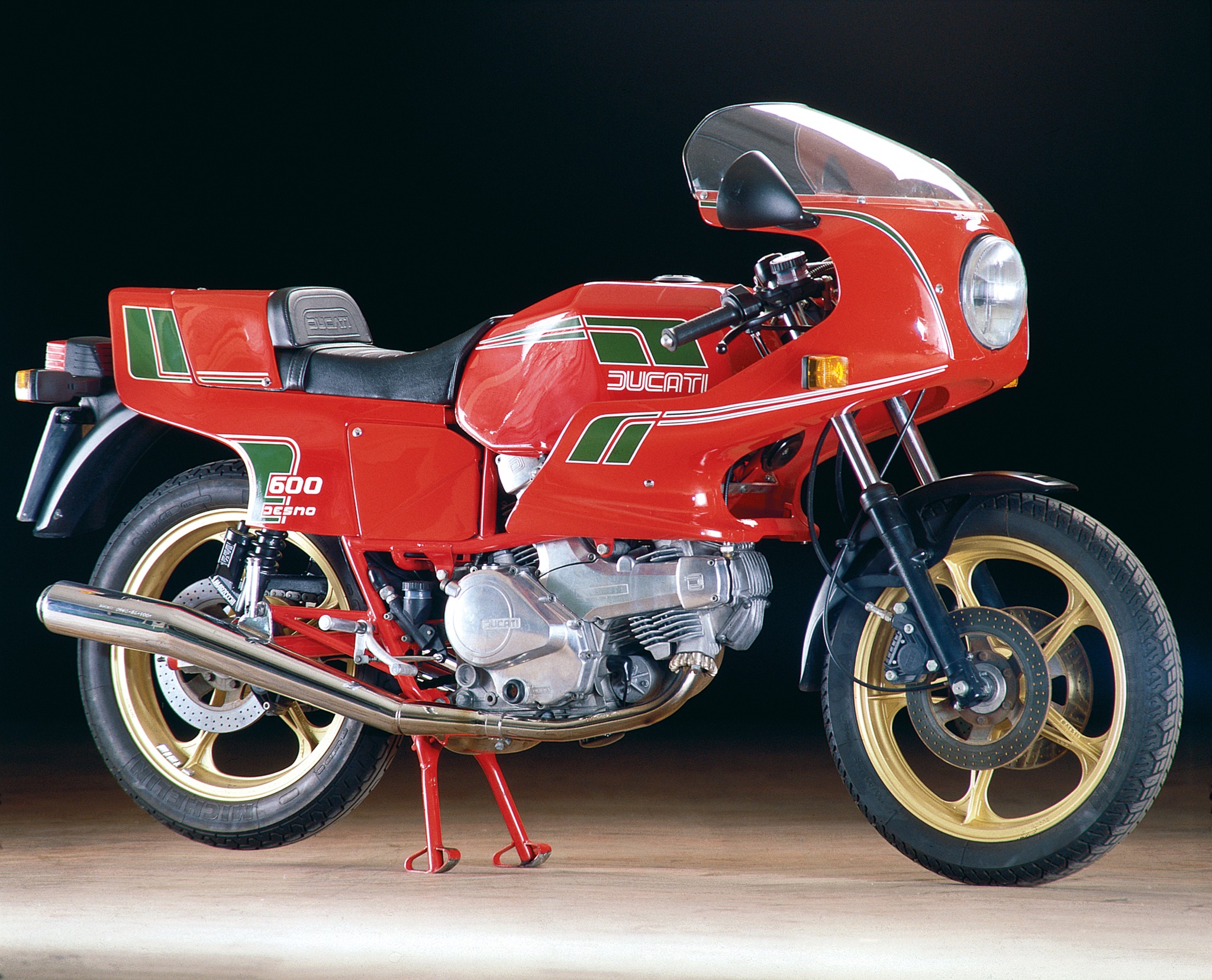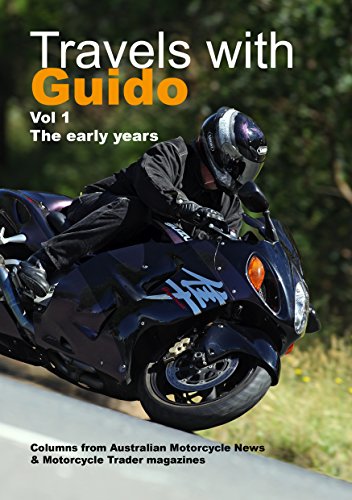Motorcycle Investor mag
Subscribe to our free email news
BMW Pantah 500/600
(by Ian Falloon, Mar 2022)

The start
of an engine dynasty
The story goes that in 1976,
when the management of Ducati finally realised that the
parallel twins were a commercial disaster, Ing. Taglioni
smiled, reached into his bottom draw, and presented them
with the full technical drawings for a 500cc V twin
engine.
The origins of the Pantah
went back to the Armaroli 500cc Grand Prix racer of
1973, and many of the features tried on this racing
engine were incorporated in the first production models
of 1979. The Pantah could have gone into production much
earlier, but the EFIM management was in turmoil.
During 1977-78, motorcycle
production at Borgo Panigale was at an all time low,
partly due to the decline in the US market, but also
because of the unsatisfactory model range, and in July
1978 control of Ducati passed to another group, the VM
Group. VM were heavily involved in diesel engines, so
they used the Ducati plant in Bologna for their
production and development of industrial diesels.
With the control of the
company in Rome, industrial diesel engine production was
increased, while that of motorcycles was decreased.
Finally, in 1979, after a two year delay, Fabio Taglioni
was allowed to put his new engine and motorcycle into
production, an engine so successful that it continues to
form the basis of the entire range of modern Ducatis.
While the range of production
bevel-gear twins remained strongly influenced by the
singles throughout their life-span, the Pantah was a
combination of the past and present. The prototype 500cc
Pantah had its roots very much in the 1971-73 racers. It
used the same bore and stroke of 74mm and 58mm, and like
the final 500 racer of 1973, used toothed belts to drive
the double overhead camshafts.
When asked by Dennis Noyes of
Motor Cycle magazine in 1977 why he chose to
change to toothed belts over bevel-gears and shafts,
Taglioni replied, “It is no more precise but it lowers
mechanical noise and will cut assembly costs. Our big
V-twins are expensive to build because of the materials,
and they have to be built with great care because of
shimming and setting up clearances. With the belt drive
we get the same accuracy without the complexity”.
Taglioni also went on to say that several aspects of the
design of the Pantah were compromised by the necessity
to use many components from the parallel twin.
While not actually built by
Ducati, the 1973 500cc double overhead camshaft, eight
valve racing engine pioneered quite a few features that
would eventually find their way to the production
engines. The engine came from another Bolognese company
Armaroli, and was based on the 500cc bevel-gear
crankcases. It still had the gearshift on the right
side, and primary drive and dry multi-plate clutch on
the left. The exposed toothed belts were driven from the
crankshaft inside the primary gears, so the drive moved
from the right side of the engine to the left.
Ignition was by a set of
contact breakers mounted on the external reduction gear.
In a move pre-empting the Paso thirteen years later, the
rear cylinder head was reversed so that both Dell’Orto
carburettors faced forward between the cylinders, with a
rear exiting exhaust pipe. Unlike the bevel-gear 500
racing engine, the front cylinder had radial finning,
similar to the Moto Guzzi racing singles of the 1950s.
Power was 74bhp at 12,000 rpm, not up significantly from
the bevel-gear engines. Mounted in one of the Seeley
frames with triple Lockheed discs and leading axle
Marzocchis, it was raced occasionally by Spaggiari in
1973 without success.
Initial development versions
of the new Pantah engine still used needle roller
big-end bearings, Ing. Taglioni being reluctant to
accept plain bearings. However, experience with the
parallel twins had some effect on his thinking. By the
time the first prototype was displayed at the Milan Show
of November 1977, it had full flow oil filtration, with
a spin on oil filter, and a one-piece forged crankshaft.
This show model also featured
a full fairing in the style of the race kit 750/900SS
fairing, and Campagnolo hydroconical brakes. Belt covers
on these early engines mimicked the cylinder head
finning. Not much development happened throughout 1978,
and for the Cologne Show in October another version was
exhibited, now with polished aluminium cam belt covers.
One month later, at Milan,
the Pantah had the Speedlines replaced by six spoke FPS
wheels. Production was announced to begin in March the
following year, but it would several months after that
before the first series was built. The pre-production
bikes were painted two-tone blue and white, but the
first series of 250 bikes, when they finally appeared
after the summer break of 1979, were red and silver.
The Pantah deviated
considerably in design from the 750/860 bevel-gear
twins. It was intended for desmodromic valves only, and
was much more compact. While using the 90º twin cylinder
layout with vertically split crankcases, the swing-arm
was also pivoted on bearings within the gearbox casing.
This was done to bring the pivot as close as possible to
the countershaft sprocket, reducing chain snatch. In
many ways the Pantah was a mirror image of the bigger
twin and earlier 500 racers.
The crankshaft was still
supported by axial thrust ball main bearings, Taglioni
being wary of the plain main bearings as fitted to the
parallel twin, with the helical primary drive gears on
the right side, and the alternator on the left. Whereas
the cylinders were offset with the horizontal cylinder
to the left on the 750/860, in the interests of keeping
the exhaust pipes more compact, this was also reversed
on the Pantah.
Also, unlike the big twin,
the flywheel with ignition trigger sat inside the 200W
alternator. The Bosch BTZ ignition system was new, and
was adapted from the same system used on the Darmah
SD900. As it was designed to be electric start only, the
starter motor was neatly fitted under the front cylinder
and drove through reduction gearing to a sprag clutch
screwed to the back of the flywheel.
The toothed belts and valve
gear were driven off a jackshaft running between the
cylinders and geared from the crankshaft on the left
side. This enabled the engine to kept much narrower (at
only 14.8 inches or 776mm) than the bigger engines that
needed to fit the geared camshaft drive inside the
alternator rotor.
The primary drive, with a
ratio of 31/69 or 2.226:1, drove a standard Ducati style
wet multi-plate clutch, something has been under
continued refinement by the factory. It is beyond the
scope of this book to detail every modification to
Ducati clutches over the years, but generally they occur
at almost annual intervals.
If there has been an Achilles
heel to the Ducati engines over the years, it has been
the clutch, and as the engines get successively more
powerful, the clutch slipping problem is exacerbated.
The Pantah clutch too was the reverse of the 860, in
that the six springs clamped the driving and driven
plates from the inside outward of the alloy clutch drum
and hub.
The forged one-piece
crankshaft necessitated the change to two-piece
connecting rods with plain bearing big-ends, and a
corresponding increase in oil pressure. Whereas the old
engines, with all their ball and roller bearings, could
run with only 15psi from its geared pump, the Pantah
flow rate was regulated to 70psi. The geared oil pump
resided in the same location as the earlier engines, but
was now driven by the helical primary drive gear.
Unlike the larger twin,
maintaining a short wheelbase wasn’t such a problem, so
the gearbox was the indirect type, with separate input
and output shafts. Consequently the engine rotated
forward, not backward as the 750/860. As with the 860
though, the first engines (to engine number 3245), used
gearboxes with six engagement dogs. Following racing 860
practice, these became the stronger three dog type in
1982.
Much of the reason for making
the Pantah a mirror image of the earlier twin was so
that the gearshift could be properly incorporated on the
left side. The cylinder barrels were also Gilnisil (an
Italian Nikasil), a plating incorporating silicon and
carbon particles that was much harder than iron,
lighter, harder wearing, and offered better heat
transfer. The only down side was that the cylinders
couldn’t be rebored.
The two valve cylinder heads
used the 60º included valve angle of the 1973 racing
bikes and parallel twins, with 37.5mm inlet and 33.5mm
exhaust valves. The desmodromic valve actuation system
mirrored Taglioni’s design for the parallel twin 500
Sport, but with the different timing figures of inlet
opening 50º before top dead centre and closing 80º after
bottom dead centre. The exhaust opened 75º before bottom
dead centre, closing 45º after top dead centre. Feeding
these cylinder heads were 36mm Dell’Orto PHF
carburettors, restricted by a large air filter on top of
the engine, under the fuel tank. Compression ratio was
9.5:1, and claimed power was 52bhp at 9050 rpm.
Supporting this engine was a
trellis type frame, also designed by Taglioni. Two pairs
of parallel tubes running from the rear cylinder to the
steering head met another pair of tubes running up from
the rear of the crankcases. This was braced for extra
rigidity.
The engine hung below the
trellis and was bolted to it at six points. It wasn’t
the most compact frame as the wheelbase was still 57
inches (1450mm), but it was considerably shorter than
the larger twins. Suspension was by Marzocchi front and
rear, with 35mm diameter forks and 310mm shock
absorbers. With clip-on handlebars, and a half fairing,
the 180kg (396lb) Pantah 500SL was still very much a
sporting motorcycle. The Nippon Denso instruments and
the switchgear were the same as on the Darmah.
When the first production
models finally appeared during 1980, they were painted a
pale blue, with red and dark blue stripes. The styling
didn’t meet with universal acclaim, and the first
500SL’s were unlike other V-twin Ducatis in that they
had very little bottom end and mid range power.
As delivered, the Pantah was
an extremely quiet bike with its toothed belt camshaft
drive, rubber plugs in between the cylinder fins and
quiet Contis. The engine liked to rev, but unfortunately
the gearing was so high at 2.533:1 that performance was
limited, and the bike wouldn’t run near to its power
peak in top gear. Motor Cycle Weekly magazine
managed 114.34mph (184km/h) in October 1980 running to
only 8500rpm in top gear.
Contemporary tests were
extremely complementary about the handling of the
Pantah. With a 30.5º steering-head angle, the Pantah was
a stable motorcycle, and the frame more than sufficient
for the modest weight and power of the 500cc engine. My
experience with 500 Pantahs was that they handled well
enough, and steered slowly and predictably, yet did
exhibit signs of looseness somewhere between the rear
wheel and steering head over bumpy roads. The 35mm forks
were lacking in rigidity too, especially by modern
standards.
The engines though, while
lacking in torque compared to an 860, were thoroughly
reliable and oil tight. A small practical problem with
Pantahs though was the slow discharge of the 12V 14Ah
battery if they weren’t used regularly.
In line with past Ducati
practice, it was obvious that a simple overbore would be
the first step in the development of the Pantah.
Already, early in 1980, a 600 Pantah with a Mike
Hailwood Replica style full fairing, had been seen at
the factory, and a factory racing kit that included
larger pistons was marketed for the 500, just as the
first production bikes became available.
The new 600SL was displayed
late in 1980 along with a prototype turbocharged Pantah
engine. Nothing came of the turbocharged version, but
the 600SL became available in early 1981, with silver
paintwork, a new fairing and a hydraulically actuated
wet clutch with stronger springs. Paioli 35mm forks were
fitted on the earliest versions, and throughout 1981 and
1982, either Marzocchi or Paioli forks and shock
absorbers appeared on the production bikes.
These also had larger, 08
Brembo front brake calipers, mounted behind the fork
legs, and a larger, 400H18 rear tyre. The 600SL was
unchanged throughout 1982 but for a black plastic front
guard. Claimed dry weight was up to 187kg (411lb).
The 500 Pantah continued
alongside the 600, and in 1981 received the 600 style
fairing, but not the hydraulic clutch. The engine cases
were standardised as they had been with the square-case
750/900SS in 1975, so that in effect, from number 1654
the 500 was a sleeved down 600 (for some reason 290
engines after this had the earlier cases).
The extra capacity for the
600 was gained in exactly the same way as the 750 had
become an 860, by a 6mm cylinder bore increase. With an
80mm bore and the 58mm stroke, capacity was 583cc, with
compression still 9.5:1. Valve sizes, valve timing, and
carburettors were shared by both models.
Claimed power was 58bhp at
8500, but by 1982 it had risen to 61bhp at 9100rpm with
compression now 10.4:1. For the 500 the power went down
to 45bhp in 1982, with no change in specification. There
were many aberrations between claimed power and weight
figures for various models at this time, but it is
difficult to believe that a simple 17% capacity increase
would equate to a 35% power boost.
The 600SL was even more
highly geared than the 500 at 2.4:1, and also wouldn’t
run to the red-line in top gear. The English Motor
Cycle News in April 1982 could only manage
117.29mph (188.8km/h), in fourth gear. It was five mph
slower in top!
Both the 500 and 600SL
Pantahs were listed through to 1984, by which time the
600 was painted in the Mike Hailwood Replica colours of
red, with green and white stripes, with a red frame.
These last 600s had also reverted to a cable operated
clutch and now had a larger, steel clutch basket. The
last 500SLs were white with red stripes.
For the Italian market, a
350SL appeared in 1983, also in the MHR colours, but
with silver FPS wheels. The 349cc engine, with a 66 x
51mm bore and stroke, 10.3:1 compression, and 30mm
Dell’Orto carburettors, produced 40bhp at 9600 rpm.
-------------------------------------------------
Produced by AllMoto abn 61 400 694 722
Privacy: we do not collect cookies or any other data.

Archives
Contact





